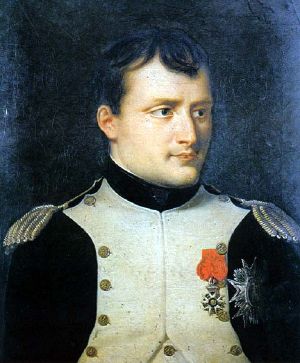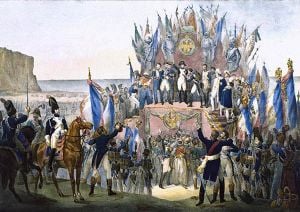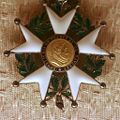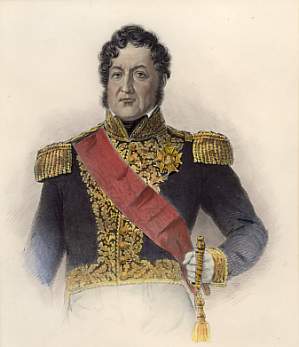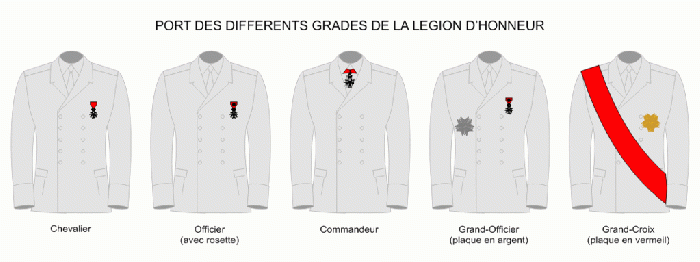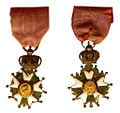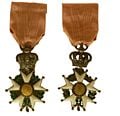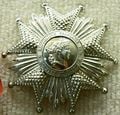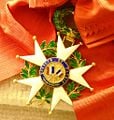Légion d'honneur
- "Legion of Honor" redirects here.
| Ordre de la Légion d'honneur | |
|---|---|
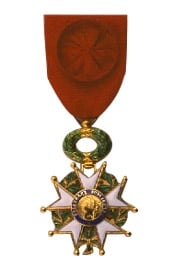 Officier medal of the French "Légion d'honneur" | |
| Awarded by | |
| Type | Order with five degrees |
| Awarded for | Excellent civil or military conduct delivered, upon official investigation |
| Status | Open since 1802 |
| Statistics | |
| Established | May 19, 1802 |
| First awarded | July 14, 1804 |
| Distinct recipients |
The maximum quotas: Knight: 125,000 Officer: 10,000 Commander: 1,250 Grand Officer: 250 Grand Cross: 75 |
| Precedence | |
| Next (higher) | None |
| Next (lower) | Ordre de la Libération |
The Légion d'honneur or Ordre national de la Légion d'honneur (National Order of the Legion of Honour) is a French order established by Napoléon Bonaparte, First Consul of the First Republic, on May 19, 1802.[1] This world-renowned Order is the highest decoration in France and is divided into five various degrees: Chevalier (Knight), Officier (Officer), Commandeur (Commander), Grand Officier (Grand Officer) and Grand-Croix (Grand Cross).
The royal orders of the Kings were all abolished after the French Revolution, but Napoleon saw a need to officially honor outstanding service and merit based on the principle of equality between military and civilian citizens. By honoring the different kinds of services rendered to the country, this new order reflected the ideals of the revolution.
The original statutes have been slightly amended over the years, but in 1962 General Charles de Gaulle restored the Legion of Honor to its original concept as a general military and civil order of merit. Today the award can be given to men and women, French citizens and foreigners, civilians and military personnel.[2]
The order's motto is Honneur et Patrie (Honour and Fatherland), and its seat is the Palais de la Légion d'Honneur on the left bank of the River Seine in Paris.[3]
History
Consulat
Prior to the Revolution The Order of St. Louis was the most popular in the French kingdom. Louis XIV founded it in 1693. It was comprised of grand crosses, commanders and chevaliers or knights, all of whom were Catholic officers of the royal army. Louis XV instituted the Order of Military Merit for Protestant foreign officers serving in France.[4]
After the Revolution it was Napoléon Bonaparte, the First Consul and de facto sole ruler, who created a reward to commend civilians and soldiers that became the Légion d'Honneur,[5] a body of men that was not an order of chivalry like the old nobility system, but an order of Merit. From its beginning it was conferred on illustrious individuals in all walks of life—the military, magistrates, administrators and civil servants as well as men of distinguished achievement in the arts, fine arts, teaching, agriculture, trade and industry.
On July 15, 1804 the first Légion d'Honneur were awarded in the Church of the Invalides with the emperor personally bestowing the awards in a grand military and religious ceremony. Along the first to be honored were eighteen marshals, five cardinals and a number of scholars, scientists, writers and composers. By 1812, 1,400 civilians had been decorated.[6]
A few weeks later on, August 16, in a solemn military ceremony held at Boulogne-sur-Mer, the troops who were to embark for England and were within sight of the enemy’s shores were personally bestowed the new honor by Napoleon.
To spur the members of the Legion to even greater efforts in the service of their country he instituted four ranks in the Legion: knight, officer, (commander until 1814), and grand-officer. In addition, Napoleon, as Emperor, added a fifth rank: grand croix (cross), called "grand-eagle" during his reign. The ranks of grand officer and grand cross are known as dignités.
First Empire
After the reestablishment of the nobility in 1808, award of the Légion gave way to the title of "Knight of the Empire" (chevalier de l'empire). The title was made hereditary after three generations of grantees.
Napoleon had dispensed 15 golden collars of the legion among his kinsmen and the highest of his ministers. This collar was abolished in 1815.
Although research is made difficult by the loss of the archives, it is known that three women who fought with the army were decorated with the order: Virginie Ghesquière, Marie-Jeanne Schelling and a nun, Sister Anne Biget[7]
The Légion d'honneur was prominent and visible in the empire. The Emperor always wore it and the fashion of the time allowed for decorations to be worn most of the time. Napoleon's personal decorations were captured by the Prussians and were displayed in the Zeughaus (armory) in Berlin until 1945. Today, they are in Moscow.
Restoration of the Bourbon Kings in 1814
Louis XVIII changed the appearance of the order, but it was not abolished because it would have angered the 35-38,000 who were already members. The images of Napoleon and his eagle were removed and replaced by the image of Henry IV, the popular first king of the Bourbon line. Three Bourbon Lilies (fleur-de-lys) replaced the eagle on the reverse of the order. A king's crown replaced the imperial crown. In 1816 the grand cordons were renamed grand crosses and the legionnaires became knights. The king decreed that the commandants were now commanders.
Although, during the Hundred Days, Napoleon had revoked the Légion d'honneurs bestowed by Louis XVIII, the Order itself was maintained; but there was an attempt to diminish its prestige by giving it second place after the Order of Saint Michael and the Royal and Military Order of Saint Louis.[8]
July Monarchy
France's first constitutional monarch, King Louis-Philippe of the House of Orleans, abolished the other orders of the monarchy and restored the order of the Légion d'honneur in 1830 as the sole decoration of the French nation. The insignia were drastically altered. The cross now displayed tricolor flags.
Second Republic
Yet another revolt in Paris (1848) brought a new republic and a new design to the Légion d'honneur.
A nephew of the founder, Prince Napoléon was elected president and he restored the image of his uncle on the crosses of the order. In 1852 the first officially recorded woman, Angélique Duchemin a revolutionary in the 1789 uprising against the absolute monarchy, was admitted into the order. President Napoleon staged a coup d'état and made himself emperor of the French in 1852.
Second Empire
An Imperial crown was added. During Napoleon III's reign the first American was admitted—Dr. Thomas Wiltberger Evans, dentist of Napoleon III.
Third Republic
In 1870 the defeat of the army in the Franco-Prussian war brought another Republic. As France changed, the Légion d'honneur changed as well. The crown was replaced by a laurel and oak wreath. In 1871, during the Paris Commune, the Hôtel de Salm, headquarters of the Légion, was burned to the ground in street fighting and the archives of the order were lost.
During the First World War, some 55,000 decorations were conferred, 20,000 to foreigners. The large number of decorations was due to the new posthumous awards authorized in 1918. Traditionally membership in the Légion could not be awarded posthumously.
The oath which the Legionnaires had previously sworn to the various regimes were abolished during the Third Republic.
Current organisation and officers
The President of the French Republic is the Grand Master of the Order and appoints all other members of the Order—by convention, on the advice of the Government. Its principal officers are the Chancellor and Secretary-General.
Current officers of the Order include:
- Grand Master: Nicolas Sarkozy
- Grand Chancellor: Jean-Pierre Kelche
- Secretary-General: Jacques Carrère
French nationals, men and women, can be received into the légion, for "eminent merit" (mérites éminents) in military or civil life. In practice, in current usage, the order is conferred, in addition to military recipients, to many entrepreneurs, high-level civil servants, sport champions[9] in as well as other people with high connections in the executive. The members of the French Parliament cannot receive the order, except for valor in war, and ministers are not allowed to nominate their accountants.
French nationals are always initially received in the légion to the class of chevalier (knight). To be promoted to a higher class, one must prove new services to France and a set number of years must pass between appointment and promotion. The only exception is the President of the Republic, who is made a grand cross de jure upon his accession to the presidency. Foreigners are not admitted in the légion as such, but may be decorated with the insignia of the légion. A foreigner can be decorated directly with the insignia of a higher class. Foreign heads of state and the wives or consorts of monarchs are made Grand Cross as a courtesy.
The Order has a maximum quota of 75 Grand Cross, 250 Grand Officers, 1,250 Commanders, 10,000 Officers and 113,425 (ordinary) Knights. As of 2000 the actual membership was 61 Grand Cross, 321 Grand Officers, 3,626 Commanders, 22,401 Officers and 87,371 Knights.
It is a popular joke that half of France wants the order and the other half already owns it, but in reality most people have to content themselves with the less prestigious "National Order of Merit" awarded for "distinguished services".[citation needed]
Appointments of veterans of the Second World War, French military personnel involved in the North African Campaign and other foreign French military operations, as well as wounded soldiers, are made independently of the quota.
In 1998, all surviving veterans of the First World War from any allied country who had fought on French soil were made Knights of the Légion if they were not so already, as part of the commemoration of the 80th anniversary of the war's end. In December 2004, on the occasion of his 110th birthday, France's oldest surviving veteran of the war, Maurice Floquet, was promoted to Officer.
Members convicted of a severe crime (plain crime in French) are dismissed de jure from the order. Members convicted of a lesser felony (délit in French) can be dismissed too.
Wearing the decoration of the Légion d'honneur without having the right to do so is an offence. Wearing the ribbon or rosette of a foreign order of knighthood is prohibited if that ribbon is mainly red, like the ribbon of the Légion.
Collective appointments can also be made to cities, institutions, companies, or military units. In the case of a military unit, its flag is decorated with the insignia of a knight, which is a different award than the fourragère. Cities proudly display the decoration in their coat of arms.
Twenty-one schools, mainly higher educations schools providing the bulk of reserve officers during World Wars, were awarded the Légion d'honneur. They share this distinction with the Red Cross, the abbey of Our Lady of Dombes and the state-railway company SNCF.
Classes and insignia
The order has five classes:
- Two dignities :
- Grand-Croix (Grand Cross): Formerly grande décoration, grand aigle or grand cordon, wears the badge on a sash on the right shoulder, plus the star on the left chest.
- Grand Officier (Grand Officer): Wears the badge on a ribbon with a rosette on the left chest, plus the star on the right chest.
- Three ranks :
- Commandeur (Commander): Formerly commandant, wears the badge on a necklet.
- Officier (Officer): Wears the badge on a ribbon with a rosette on the left chest.
- Chevalier (Knight): Formerly légionnaire, wears the badge on a ribbon on the left chest.
| Ribbon bars | ||||
|---|---|---|---|---|
| Knight | Officer | Commander | Grand Officer | Grand Cross |
The sitting President of the Republic, as grand master of the order, wears the Grand Collar of the Légion, which is presented to him upon his investiture.
The badge of the Légion is a five-armed 'Maltese Asterisk' (for want of a better description—see Maltese Cross) in gilt (in silver for chevalier) enameled white, with an enameled laurel and oak wreath between the arms. The obverse central disc is in gilt, featuring the head of Marianne, surrounded by the legend République Française on a blue enamel ring. The reverse central disc is also in gilt, with a set of crossed tricolores, surrounded by the Légion's motto Honneur et Patrie (Honour and Fatherland) and its foundation date on a blue enamel ring. The badge is suspended by an enameled laurel and oak wreath.
The star (or "plaque") is worn by the Grand Cross (in gilt on the left chest) and the Grand Officer (in silver on the right chest) respectively; it is similar to the badge, but without enamel, and with the wreath replaced by a cluster of rays in between each arm. The central disc features the head of Marianne, surrounded by the legend République Française (French Republic) and the motto Honneur et Patrie.
The ribbon for the badge is plain red.
The badge or star is not worn usually, except at the time of the decoration ceremony or on a dress uniform. Instead, one normally wears the ribbon or rosette on one's suit.
Gallery of images
Chiang Kai-shek's Légion d'honneur plaque. In his days the plaque was made of silver.
The Order and other countries
- In the United States, Generals of the Army Dwight Eisenhower and Douglas MacArthur are among the 10,000 Americans who have received the decoration. In 1949, the Academies of West Point and Annapolis were also decorated. Although it is rare for an ambassador in Paris to be awarded the Légion d'honneur, a posthumous exception was made for the United States ambassador Pamela Harriman in 1997. The last surviving American World War I veteran, Frank Buckles, also received this honour.
- Additionally, in the United Kingdom Queen Elizabeth II, Prince Philip and the late Lord Mountbatten and have been decorated with the Grand Cross.
- Australian General Sir John Monash was decorated with the Grand Officer during the First World War.
- King Carl XVI Gustaf of Sweden has been decorated with the Grand Cross.
Locations associated with the Order
A grand total of 68 cities and villages, amongst them Liège in 1914, Belgrade in 1920, Luxembourg in 1957 and Stalingrad (today's Volgograd) in 1984 were decorated, as were 51 regiments and the Military School of Autun.
The Order has its own élite boarding schools in Saint-Denis and Les Loges in the forest of Saint-Germain-en-Laye. A thousand children and grandchildren of the members of the order are educated there. Any descendants of a recipient can study there.
See also
- List of Légion d'honneur recipients by name
- List of prizes, medals, and awards
- Musée national de la Légion d'Honneur et des Ordres de Chevalerie
- Order (decoration)
- Order of the Garter
- Order of the Golden Fleece
- Ordre de la Libération
- Ordre National du Mérite
- Ribbons of the French military and civil awards
- State decoration
Notes
- ↑ French, translatable as "Legion of Hono(u)r" (see spelling differences), but known as the Légion d'honneur to avoid confusion with similarly-named decorations (e.g. the Philippine Legion of Honour)
- ↑ Dunn, Jo. 2003. The Legion of Honor: A Personal Story Paristempo.com. Retrieved July 30, 2008.
- ↑ The award for the French Legion of Honour is known by many titles, also depending on the five levels of degree: Knight of the Legion of Honour; Chevalier de la Légion d'honneur; Officer of the Legion of Honour; Officier de la Légion d'honneur; Commander of the Legion of Honour; Commandeur de la Légion d'honneur; Grand Officer of the Legion of Honour; Grand Officier de la Légion d'honneur; Grand Cross of the Legion of Honour; Grand-Croix de la Légion d'honneur. The word "honneur" is often capitalised, as in the name of the palace Palais de la Légion d'Honneur.
- ↑ [1]
- ↑ Pierre-Louis Roederer, "Speech Proposing the Creation of a Legion of Honour," Napoleon: Symbol for an Age, A Brief History with Documents, ed. Rafe Blaufarb (New York: Bedford/St. Martin's, 2008), 101-102.
- ↑ [2]
- ↑ The first recorded women's award is 1851, under Louis-Napoléon Bonaparte.
- ↑ [3]
- ↑ All Olympic Gold Medal winners are awarded the Légion.
ReferencesISBN links support NWE through referral fees
External links
- Légion d'honneur (French)
- Dunn, Jo. 2003. The Legion of Honor: A Personal Story
- The Legion of Honor Ambafrance-au.org.
- Legion of Honor Ambafrance-us.org.
| ||||||||
Credits
New World Encyclopedia writers and editors rewrote and completed the Wikipedia article in accordance with New World Encyclopedia standards. This article abides by terms of the Creative Commons CC-by-sa 3.0 License (CC-by-sa), which may be used and disseminated with proper attribution. Credit is due under the terms of this license that can reference both the New World Encyclopedia contributors and the selfless volunteer contributors of the Wikimedia Foundation. To cite this article click here for a list of acceptable citing formats.The history of earlier contributions by wikipedians is accessible to researchers here:
The history of this article since it was imported to New World Encyclopedia:
Note: Some restrictions may apply to use of individual images which are separately licensed.
